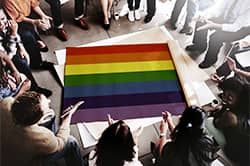LGBT Rehab Centers
 Substance use, abuse, addiction, and dependence are especially problematic among people that identify as LGBT.4 These risks apply to LGBT adults as well as youth that identify as LGBT.4,5,6 In this article, LGBT is used as an inclusive term that describes a person who identifies as lesbian, gay, bisexual, transsexual, or any other sexual minority.
Substance use, abuse, addiction, and dependence are especially problematic among people that identify as LGBT.4 These risks apply to LGBT adults as well as youth that identify as LGBT.4,5,6 In this article, LGBT is used as an inclusive term that describes a person who identifies as lesbian, gay, bisexual, transsexual, or any other sexual minority.
According to a 2015 survey by the Substance Abuse and Mental Health Services Administration (SAMHSA), sexual minorities were:4
- More likely than their heterosexual counterparts to have abused illicit drugs in the last year.
- More likely to have used cigarettes in the last month.
- More likely to have used and binged on alcohol in the past month.
- More likely to have substance use and mental health disorders.
An LGBT rehab center exclusively treats LGBT people or takes addition steps to ensure that all individuals are treated in a safe and respectful way. By participating in a setting that is tailored to their distinctive needs, a person who identifies as LGBT can start to live drug-free.
![]() If you or a loved one needs substance abuse treatment and could benefit from a specialized LGBT recovery center, call 1-866-806-7002 today to learn more about accessing gay rehab centers or gay-friendly rehab centers.
If you or a loved one needs substance abuse treatment and could benefit from a specialized LGBT recovery center, call 1-866-806-7002 today to learn more about accessing gay rehab centers or gay-friendly rehab centers.
Treatment Approach
An LGBT treatment center shares many similarities with traditional substance abuse treatment. Like other rehab centers, gay drug rehab focuses on abstinence-based approaches to begin and maintain recovery from alcohol and other substances.7 The same goals of safely ending use, building healthy supports, and maintaining recovery are at the forefront.
Staffed with people who understand the needs of the LGBT community.
However, LGBT rehab centers deal with LGBT-specific issues such as stigma, trauma, abuse, and harassment. They are open and accepting of LGBT patients, and bring together peers who are of the same sexual orientation. Patients are surrounded by other people who understand what they are going through. These programs also treat co-occurring mental health issues, such as depression and anxiety.
They are staffed with people who understand the needs of the LGBT community. The staff may be LGBT people in recovery as well.
LGBT Rehab Center Staff
The staff at an LGBT rehab center have a major impact on the center’s treatment approach. Strong treatment will be provided by staff that comply with principles of care such as:7
- Being flexible and client-focused. Although clients will be LGBT, they will not all be the same. With flexibility towards the client’s needs, the professionals can better treat each person.
- Being coordinated and comprehensive. Treatment at a gay rehab center should address, in a multifaceted way, all sources of addiction, such as mental health and family relationships. As discharge draws near, staff should work with the individual to link to a suitable level of continuing care.
- Being informed. Professionals will acknowledge and process issues of trauma, abuse, bullying, and violence that LGBT people frequently experience, especially younger members of the group.5,6
- Building self-respect. With current stigmas and discrimination, LGBT people frequently have diminished self-esteem. By acknowledging this need, staff can take steps to actively build and reinforce higher self-worth.
- Building healthy behaviors/decision-making. At times, aspects of the LGBT lifestyle can be intertwined with substance use. Staff can help clients separate the two, leading to improved decision-making skills and a healthier life.
By pairing people that face the same challenges with experienced staff, there is a significant opportunity to achieve and maintain a life free from alcohol and other drugs through a level of understanding and acceptance.
Recovery Process and Services

The best setting for recovery is one that meets the needs of the individual without being too restrictive. A thorough assessment performed by a substance abuse professional can identify the level of need and recommend the best course of treatment.
One type of substance abuse evaluation is called Screening, Brief Intervention, and Referral to Treatment (SBIRT). Available in hospitals, workplaces, and doctor’s offices, SBIRT offers:9
- Screening of substance use disorders and possible risk factors to identify presence and intensity of addiction/physical dependence.
- Brief intervention to discuss symptoms and build motivation to modify problematic behaviors.
- Referral to treatment, when necessary, while considering issues like the severity of symptoms, transportation, and insurance coverage.
Detox
When treatment begins, it will often focus on detoxification.1,2,8 Detoxification (detox) improves safety and comfort while the substances are removed from the body. Medically assisted or medically supervised detox is an important step for someone physically dependent on a substance, since a person can experience dangerous withdrawal symptoms when they reduce their use or stop using altogether.8 Detox can occur in a variety of treatment settings.8
Therapy
After detox, treatment will shift to psychotherapy that strives to change thinking and behavior patterns that fuel substance use. Available treatment options include:
- Individual therapy – one-on-one meetings between a therapist and the individual in recovery to address specific needs and goals.
- Group therapy – meetings with other people in recovery and one or more therapists to address different aspects of addiction.
- Family/couples therapy – sessions that include the individual’s family or significant others. Family therapy is especially valuable in the LGBT community due to unresolved issues related to sexual identity. Family therapy can build a stronger relationship based on understanding and acceptance. Other residents in a gay drug rehab may use family therapy to strengthen connections to their family of choice, a group made of unrelated supports.
Therapy will likely focus on topics including:
- Mental health concerns such as depression, anxiety, and post-traumatic stress disorder (PTSD).
- Anger management.
- Body image issues.
- Trauma.
- Relapse prevention.
- Aftercare planning.
Medication
People in a gay rehab center may be prescribed medications to address mental health or substance use concerns. Medications can be prescribed to limit withdrawal symptoms and decrease cravings.1,2,8 Patients may also receive antidepressants or other medications to help with underlying mental health problems or the emotional effects of withdrawal.
12-Step Programs
Outside of professional treatment, support groups such as 12-step programs are helpful for many in recovery. Though some in the LGBT community may fear discrimination from groups such as Alcoholics Anonymous (AA) or Narcotics Anonymous (NA) because of the perceived religious values inherent to the group, these groups are welcoming to everyone.7 Some areas may offer 12-step groups specifically for the LGBT community.7
Aftercare
Before patients leave, they will be set up with an aftercare plan. This plan includes options for ongoing care after rehab. Aftercare participation helps people stay connected to the recovery community, continue to receive support, and avoid relapse. Types of aftercare include 12-step meetings, individual counseling, group therapy, and sober living.
![]() A wide range of substance abuse services is available for people in the LGBT community.
A wide range of substance abuse services is available for people in the LGBT community.
Call 1-866-806-7002 today to learn more about services to fit your needs.
Locating a Program

Based on an individual’s symptoms and supports, they can choose from a number of treatment settings that vary in duration of stay and intensity. Some options include:
- Inpatient or residential. Ranging in duration from a few days to many months, inpatient/ residential treatments involve leaving home to live in the treatment center while receiving services. These treatments are best for people with more severe symptoms or fewer supports in the community.
- Partial hospitalization programs (PHPs). Technically an outpatient program because it allows the individual to sleep in their home, PHPs consist of treatment several hours per day, up to 5 days per week. PHPs can include a combination of individual, group, and family therapy.
- Intensive outpatient programs (IOPs). IOPs are similar to PHPs, with the main difference being the lower intensity of services. IOPs may be several hours per day, for a few days per week.
- Outpatient. A good option for those with relatively less problematic addictions and addiction-associated issues as well as strong support. Traditional outpatient may include individual, group, or family sessions that occur for about an hour per week.
Someone interested in seeking specialized treatment should consider the LGBT sensitivity of the gay-friendly rehab center. Rated on a spectrum, the sensitivity refers to how accommodating a program is to sexual minorities. The range of sensitivity levels includes:7
- LGBT-Tolerant. These programs will have minimal sensitivity. Sexual identity may be mentioned, but not addressed openly.
- LGBT-Sensitive. With a moderate level of sensitivity, staff and clients can be open with their sexuality with groups and workshops focused on LGBT issues.
- LGBT-Affirming. Having the highest level of sensitivity, these programs will only target people that are LGBT with all sessions specifically addressing recovery as a sexual minority.
Other practical issues that are important when making a treatment choice include:
- Treatment location.
- Treatment cost/insurance coverage.
- Duration of treatment program.
- Engagement/comfort with staff.
- Reviews available online.
Some programs may offer an LGBT track and integrate LGBT patients with the general population. Think about whether that’s something you’re comfortable with, or if you would be more comfortable with an exclusive LGBT program.
LGBT Substance Abuse Statistics
According to SAMHSA:4
- 39% of sexual minority adults used an illicit drug in the last year compared to about 17% of sexual majority adults.
- 32% of sexual minority adults smoked cigarettes in the last month compared to 20% of sexual majority adults.
- 63% used alcohol in the last month compared to 56% of sexual majority adults.
- 15% have a substance use disorder compared to about 8% of sexual majority adults.
According to Youth.gov:5
- As many as 34% of LGBT students attempted suicide compared to 9% of heterosexual students.
- As many as 53% of lesbian and gay students and nearly 63% of bisexual students report feeling hopeless compared to 29% of heterosexual students.
- LGBT students that experience high levels of family rejection due to their sexuality are 3.5 times more likely to abuse substances.
LGBT youth are more likely to experience additional stress that can contribute to substance use. The Centers for Disease Control and Prevention (CDC) reports:6
- LGBT youth are more likely to be bullied at school.
- As many as 28% of LGBT youth have been threatened or injured at school.
- More than 30% of LGBT youth have been forced to have sexual intercourse.
- About 30% of LBGT youth experience dating violence.
![]() LGBT rehab centers can provide a level of care and understanding needed to begin or maintain recovery from substance use. By calling 1-866-806-7002 today, you can speak to a representative about your treatment options.
LGBT rehab centers can provide a level of care and understanding needed to begin or maintain recovery from substance use. By calling 1-866-806-7002 today, you can speak to a representative about your treatment options.
Sources
[1]. National Institute on Drug Abuse. (2012). Principles of Drug Addiction Treatment: A Research-Based Guide (Third Edition).
[2]. National Institute on Drug Abuse. (2016). DrugFacts: Treatment Approaches for Drug Addiction.
[3]. Substance Abuse and Mental Health Services Administration. (2014). Recovery Services Provided by Substance Abuse Treatment Facilities in the United States.
[4]. Substance Abuse and Mental Health Services Administration. (2016). Sexual Orientation and Estimates of Adult Substance Use and Mental Health: Results from the 2015 National Survey on Drug Use and Health.
[5]. Youth.gov. (n.d.). LGBT Behavioral Health.
[6]. Centers for Disease Control and Prevention. (2014). LGBT Youth.
[7]. Substance Abuse and Mental Health Services Administration. (2012). A Provider’s Introduction to Substance Abuse Treatment for Lesbian, Gay, Bisexual, and Transgender Individuals.
[8]. Substance Abuse and Mental Health Services Administration. (2015). Detoxification and Substance Abuse Treatment.
[9]. Substance Abuse and Mental Health Services Administration. (n.d.). SBIRT: Screening, Brief Intervention, and Referral to Treatment.
[10]. National Institute on Drug Abuse. (2014). Principles of Adolescent Substance Use Disorder Treatment: A Research-Based Guide.
